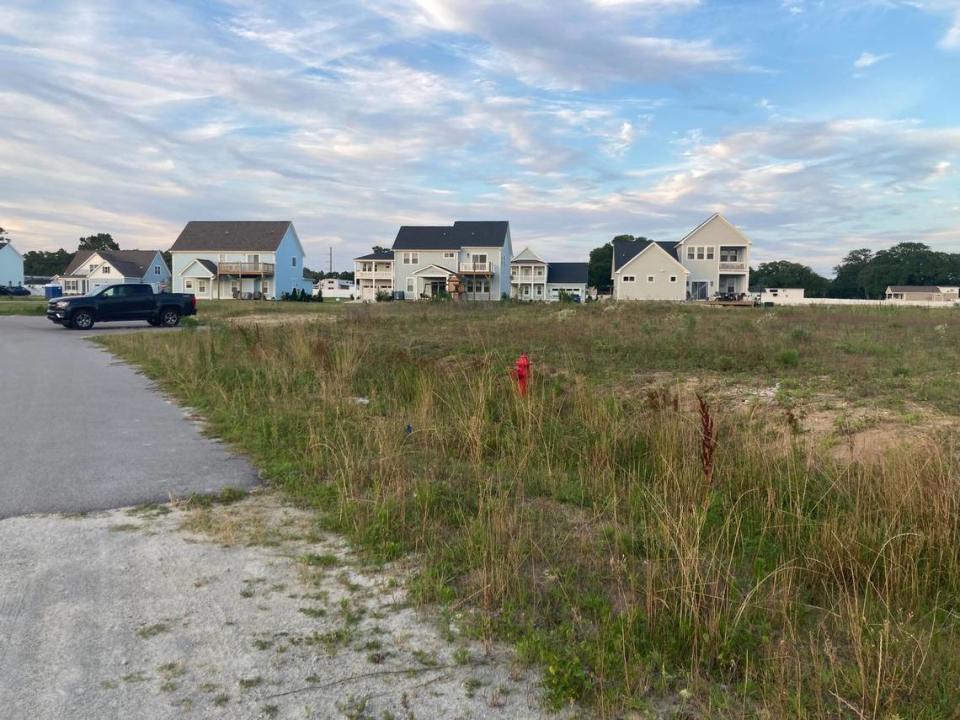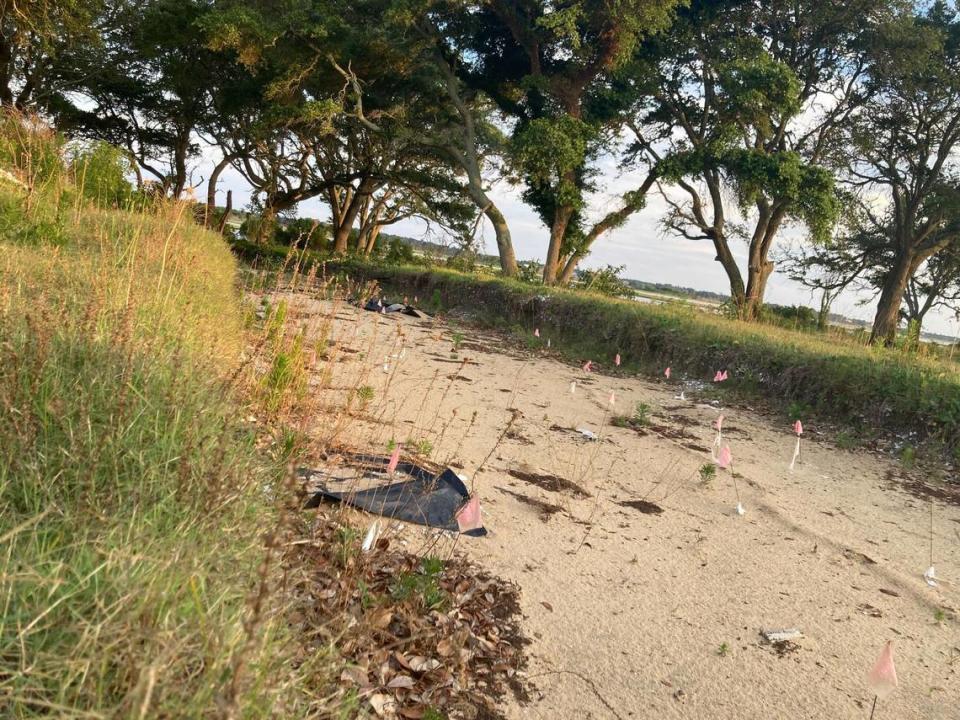NC bill threatens historic coastal areas, including a Native American burial site
A bill moving through the General Assembly would allow developers in the state’s 20 coastal counties to build on archaeological sites, including one in Carteret County that state archaeologists say could be the location of a village where Native Americans lived for thousands of years.
Under a provision added to House Bill 385, the “incidental disturbance of archaeological resources” would not be considered major and irreversible damage. That would prevent the N.C. Division of Coastal Management from holding up development permits in designated coastal Areas of Environmental Concern based on archaeological concerns raised by the N.C. Department of Natural and Cultural Resources.
At the center of the debate is a 21-acre portion of Bridge View, a development in Carteret County’s Cedar Point that borders Bogue Sound and is in a designated Area of Environmental Concern. Based on two archaeological sites found on the tract in the 1970s, the N.C. DNCR recommended an archaeological survey.
That survey included the removal of topsoil from 1.13 acres of the site. More than 2,000 artifacts were found, including 11 sites that archaeologists believe contain human remains, according to a letter from DNCR to the N.C. Division of Coastal Management.
In addition to the burial sites, archaeologists found 1,700 molds of building posts that could have been part of at least seven buildings, 206 small pits, 45 large pits, 34 pits containing shells, three shattered clay pots and a cache of stones shaped so they could be used as tools. Archaeologists believe artifacts found at the site date from 1000 B.C to 1600 A.D., around the time that Europeans made contact with Native Americans.
“This is a long-term habitation site. This is a village where people lived for generations — hundreds or thousands of years,” Chris Southerly, North Carolina’s acting state archaeologist, told The News & Observer.
There are likely more burial grounds spread across the site, Ramona Bartos, the state’s deputy state historic preservation officer, wrote in a Dec. 14 memo to coastal officials. The burials that were found were spread across the site virtually from end-to-end, Southerly said; additional remains were found in a lot of the already completed portion of the development.
Just as important, Southerly said, the artifacts have not been disturbed.
If excavation or further tests occur, Southerly said, an archaeologist might be able to use artifacts found there “to really build a picture of what life was for the people there. How they lived, what they ate, identify activity areas to get a glimpse into the past of their life and their life place.”
Development in progress
On a June evening, a gated entrance to the Bridge View Community stood open. Sprinklers ran and people walked their dogs around the more inland portion of the development, which has already finished and still-under-construction homes.
Farther on, the completed homes slowly filtered away, and the road switched from pavement to dirt. There, a series of trenches line the southern edge of the property. Those trenches seemed to be almost in the shadow of the B. Cameron Langston Bridge, which connects Cedar Point to Emerald Isle.
Down in the trenches, a plethora of pink flags dotted the sites, marking where archaeologists had located artifacts. Some small plants had started to grow inside them, indicating that it had been some time since the ground was disturbed.
When a News & Observer photographer visited the site the next day, he was told the area is private property and was escorted out by a law enforcement officer in an unmarked car.

The development proposal
Cedar Point Developers LLC, the group that wants to build on the Carteret County site, has spent more than $500,000 on archaeological work, Sen. Michael Lazzara, an Onslow County Republican, said last week during a Senate committee meeting.
Cedar Point Developers first sought the Coastal Area Management Act, or CAMA, permit in May 2022. A Nov. 20, 2023, letter from the developer to the state said the developer would not pay for any further work to determine the extent of the archaeological site.
“I think we can all agree that if we dig hard enough and long enough, that we can potentially find things all along the coast or in places that already have been built or may be built. But again, I think we need to find a balance between what North Carolina needs in housing needs and what our permitting process is making them do,” Lazzara said.
DNCR data shows that reviews leading to extensive archaeological work is rare. Between 2020 and 2023, the state reviewed 737 projects that were seeking major coastal permits. It recommended archaeological work on 13.
A representative of Cedar Point Developers did not respond to a phone call seeking comment about the development or the legislation. Partners in the Jacksonville company have donated $7,500 to Lazzara’s campaign since 2022, WRAL previously reported.
During the committee debate, Sen. Mike Woodard, a Durham Democrat, said arguments for affordable housing are not enough to justify disturbing burial sites or other potentially important historic sites.
At least three homes were sold in Bridge View during May, with prices ranging from $555,475 to $673,230.
Assuming the buyers paid 20% down and found a 7% mortgage rate, monthly mortgage payments on the cheapest of those homes would be $2,956. The U.S. Department of Housing and Urban Development considers a home affordable if monthly payments are lower than 30% of a household’s monthly income.
In Carteret County, the median income is $66,799, according to the U.S. Census Bureau. That means monthly payment on an affordable home would be about $1,670.
“While we’re all supportive of affordable housing, let’s not use that umbrella or wrap a project up in affordable housing and ignore some of the conversations that we ought to be having around CAMA and around some of these heritage sites,” Woodard said.
Protecting burial grounds, culture
The DNCR letter to coastal management officials offered a number of solutions for the site, including additional survey work and excavation of artifacts, a process that is complicated because removing human remains is generally discouraged unless it is absolutely necessary.
Alternatively, DNCR suggested selling lots to nonprofits to remain undeveloped or to limit the amount of space that would be built upon. Beyond that, the DNCR official wrote, the builder should consider putting houses on pylons to avoid disturbing land, using a sewer package plant instead of septic fields, or protecting known burial sites.
The best approach would be to cease developments and to allow the burials to remain in place, said Crystal Cavalier-Keck, a cofounder of the Native American environmental justice organization 7 Directions of Service.
“It really speaks volumes about the level of greed and how much money plays in people’s lives — because if I found a burial site and if it was my land, I would just stop and honor that. We all have loved ones who have passed away and are buried, and we wouldn’t want their places disrespected,” said Cavalier-Keck, a member of the Occoneechee Band of the Saponi Nation.
The proposed legislation would affect other coastal counties, too, including the northeastern corner of the state where people who identify as Chowanoac Indians have lived for generations. The tribe’s historical range covers Bertie, Chowan, Gates and Hertford counties, all of which are coastal counties and thus subject to CAMA regulations.
“It’s important to keep those discoveries there so we can maintain our culture or we can enforce what we already know instead of erasing it,” said Duvonya Chavis, a member of the Chowanoac tribe.

A first step?
House Bill 385 has passed one Senate committee and next goes to the chamber’s Judiciary committee. If approved, it would then go to the Rules committee before receiving a full vote on the floor. It would next move over to the House and need to move through committees there before potentially heading to Gov. Roy Cooper.
Archaeologists are worried that if the bill passes, it could be the first move to threaten archaeological sites statewide for the sake of development. During committee debate last week, one lawmaker showed interest in widening the geographic scope of rules that allow developers to disturb archaeological sites.
Sen. Jim Burgin, a Harnett County Republican, said someone in his district spent $300,000 investigating a site after artifacts were found there, even though arrowheads and other artifacts are common in the area.
“It’s bigger than the coastal area,” Burgin said.
Allowing development in such a manner would be heartbreaking, Steve Davis, a UNC-Chapel Hill archaeology professor emeritus, told The News & Observer.
“All of these sites are important in terms of informing us about the past,” Davis said. “We can’t go to written records to find out about it. If we’re going to learn anything about these ancient people, it has to come through archaeology and it has to come through investigation of these sites.”
NC Reality Check is an N&O series holding those in power accountable and shining a light on public issues that affect the Triangle or North Carolina. Have a suggestion for a future story? Email realitycheck@newsobserver.com
This story was produced with financial support from the Hartfield Foundation and Green South Foundation, in partnership with Journalism Funding Partners, as part of an independent journalism fellowship program. The N&O maintains full editorial control of the work. If you would like to help support local journalism, please consider signing up for a digital subscription, which you can do here.


